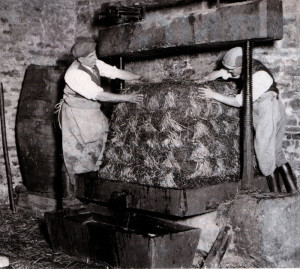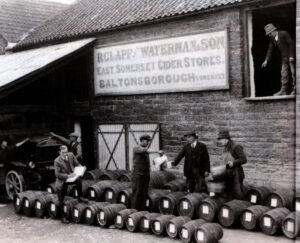
A selection of Somerset memories recorded in conversations by the Somerset Rural Life Museum captures (among other things) a bygone age when people made their own food from start to finish.
Somerset has always produce good cider apples and still does for a number of cider companies. There are lots of traditions around cider in Somerset. Cuthbert Rose was born in 1907 and was a cider maker.
“We needed nearly 30 hundredweights to two tons of apples to make what we call a ‘cheese’ and you really want about six people. One dealing with the bags of apples, pouring the apples out into the bushel basket; someone else who lifts that basket up and keeps the apple mill fed.
The mill crushes them. Then you want someone with a shovel at the mill to shovel the crushed apples, the pomace, onto the bed of the press. Then you want one, preferably two, chaps building the cheese so they can arrange each lissom or layer of apple pomace on the bed with a layer of straw – reed, as we call it. Each lissom is four or five inches thick, and we usually build up about seven or eight lissom to a cheese. Even without any pressure at all, by the time we have put up a cheese, we have probably run out about 40 odd gallons of cider, which comes out solely under the weight of the cheese itself.”
There’s a lot of romance attached to the old varieties of apple (and pear) but Cuthbert reckoned that they didn’t even know the names of most of the apples.
They called them hangdowns, moonshines and sheepnoses among other things. Cuthbert simply knew that one orchard could make better cider than the next, one orchard would have sharper fruit than the other. So they blended orchards to make the best cider.
Cider remedies
Gladys Withers was born in 1910 in Babcarry. Her family were great believers in the healing powers of cider.

“If we had colds as children, some cider would be heated and root ginger grated into it and brown sugar or golden syrup or honey put in to make a beverage and we would drink it as hot as we could in a little glass. It was a sure cure for a cold.
My father, if he had a cold, he would have some toast made and it must be burnt black, and cut up in cubes and put in a bowl and this hot cider lashed with the ginger, and oh, quite a sizeable glass of whisky and brown sugar. And he would eat that, and drink what was left afterwards, and that was a very good cure for colds, supposed to be.”
Gladys’ father had the gout, and one of his work hands suggested it was all down to the cider. The doctor was called…
“…and my father said ‘Doctor, do you think drinking cider has brought on this attack of gout?’”
The doctor smiled to himself and gave her father some pills.
” ‘Now be careful to take these regularly and wash them down with some of your best quality cider’. “








